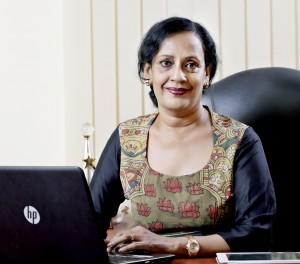Indian lingerie Industry is on an year-on-year growth curve of 17% compounded annual growth rate. With time the organised lingerie segment has been looking extremely promising and have been recording a very positive growth too. But going deeper into the everyday working of the industry brings us closer to the fact, that more than 35% professionals who are employed by the industry are not trained professionals.
This majority population is actually unskilled when they are hired to perform a particular job. It is through their everyday work, that they gain a hands on training on the job and become experienced. But the limitations of training prior to employment does prove a barrier in the path of long term association with the employee for the brand and is also a hindrance when it comes to yielding the maximum quality from the professional.
So is there a solution? Does the industry too validate that 35% professionals who are employed by the industry are not trained professionals? Let’s hear it from the experts and head honchos for prominent brands from the lingerie industry and introspect if we can actually find a way that acts as a solution to this problem.
VENKATESH RAJAMANI
Independent Consultant
Rajamani brings with him a wealth of Indian and international experience. In his last assignment as CEO of Amante, Rajamani spearheaded business strategy and performance by providing leadership through increase in trading areas, template profitability and consolidating operations and merchandising functions. He has also held senior positions at Lifestyle, shoppers stop and spencers to name a few. He also has several years of experience in Retail in the Middle East.
It is true that professionals in the lingerie industry in India are trained more on the job than pre trained. There are a 4 major causes for this:
Firstly, the reason for this is the size of the category has a huge influence on the number of entrants wanting to choose this category as an option, as it is extremely small. Look at the FMCG zone, it is an aspirational category for any professional. Secondly, brands have not taken the initiative to set up a training institute to pre train professionals which could be a huge opportunity for brands to consider this as a part of their HR(D) initiative.
Thirdly, sadly we also find more of male professionals who choose to enter this category more by default than design as a career option which also needs to be introspected and why do girls not choose this as a career option. We find a lot of consultants but not at senior levels Fourth and the final outcome of this is that the category has not been able to grow talent (professionals) which has a huge impact on the quality outcome be it product knowledge, selling techniques, objection handling from retailers and customers.
We also completely miss out on the issues faced by the end user as we do not understand the category which I would call as ” customer perspective”.
So I would strongly bat for the need to have trained professionals before they jump into this category which then helps build confidence, sustainability and avoid attrition.
SHEELA KOCHOUSEPH
Managing Director V-Star Creations Pvt.Ltd.
Sheela Kochouseph Chittilappilly is well known for her Kerela based lingerie brand V-Star. Having marked its inception in 1995, V Star under the supervision of Ms. Sheela, had flourished as a leading lingerie and intimate apparel label in India and abroad. The process of raising a brand from the grass root level doesn’t go free of hurdles. Yet it was a ardent endeavour for Ms. Sheela Kochouseph who continues to prosper and motivate women all across India with her endless passion and hardwork. Born in a family wherein she was exposed to garment making and business perspectives from a very young age, Ms. Sheela has only lapped up the positives of her early exposure and has embarked upon the same in her eventful ride with V-Star.
I am totally in agreement with the observation that “ABOUT 35% PROFESSIONALS IN THE LINGERIE INDUSTRY DOES NOT GET ANY FORMAL TRAINING!”. In fact, in my opinion, the percentage may be even higher. In India, the lingerie industry is badly in need of more trained and professional hands at every stage. From designing to production to marketing, industry needs professionals with specialised knowledge. Also there is no means to give training in pattern making and fitting and stitching lingerie in this country. If L&L can take some initiative in this regard it will be great.
We are providing several external as well as on-the job training programmes to our employees at regular intervals in order to equip them to fulfil the organizational goals.
Industry leaders should really put their heads together and do something about this talent crunch. May be one solution will be to start an institution where all stake holders will invest and where industry veterans will impart training to aspiring students. These students can be recruited by leading lingerie brands, thus providing assured employment. This will be a win-win situation, where brands can hire professional staff and youngsters can get well paying jobs.
HARSHAD THAKKAR
CHAIRMAN & MANAGING DIRECTOR
Mr. Harshad Thakkar began his journey in the intimate wear industry at his uncle’s showroom in a small village in Kutch, Gujarat. He embarked on this journey at the age of 18 and brings over 2 decades of experience to the table. He started his own venture in 1999 and opened his first manufacturing unit in 2006. The huge influx of orders required the opening of a bigger plant at Thane where AIFL is currently situated.
He is associated with AIFL since incorporation and is knowledgeable about all aspects of the business. Mr Thakkar is also the Chairman of the Lingerie Committee, Clothing Manufacturing Association of India (CMAI)
In my view, this statement is cent % true, I would completely agree that professionals in the Lingerie industry are trained on job and there is no pre- training that they receive. To be precise, more than 50% professionals in the lingerie industry are trained on job. Although, sales training is something all brands /companies do give but that is more generic and is not Lingerie specific, to be precise. Apart from sales, no other department gets a specialized training as such.
There are various institutes at present that are specialised to impart state-of-the-art training in fashion studies but these are again all too generic and one cannot find an institute that is totally equipped to provide training on Lingerie and lingerie specific on the job requirements, as a separate category. Lingerie as an industry is evolving and has been taken quite seriously by major chunk of the consumers over the last few years, but this certainly is in its nascent stage and it will surely take a lot of time before the industry at every quarter gets skilled professionals.
Women of all age groups are getting more and more conscious with their tastes where Lingerie is concerned. If at all specialized institutes are set up for training specifically for the Lingerie sector , there are high chances of the same becoming highly successful, as it is the need of the hour now. As one says, learning is an ongoing process and hence , one keeps learning throughout his/her working tenure but at the same time, if we expect 100% results and outcome, training is something which will definitely help in getting the desired results.
NISCHAL PURI
MD, Horizon Consulting India
With an experience of more than 20 years up his sleeves, Nischal Puri a veteran in the apparel and retail industry today, has begun his own consultancy firm, Horizon India. After seeing many notable lingerie brands to their glorious present. He is a successful entrepreneur and an established thought leader and consultant.
The evolution of any industry and its segments are directly proportional to 2 critical factors: one is the technology infusion and technological enhancement in the category and the second being the skill sets of the people associated with the industry segment. Lingerie industry first showed signs of evolution in India roughly a decade back .The industry has suffered substantially on the account of absence of trained manpower. The key skills where the manpower skill shortages have been observed are predominantly design and technical skills.
While the fashion design institutes have one module that claims to teach the students about the lingerie design and technical aspects but the same are highly deficient from the ability of the students to add value to the brands they get engaged in. The design institutes have not worked out a detailed lingerie specialty program. The program ideally should have 2 branches one being lingerie design and the other being lingerie pattern making and technical skills.
It will not be erroneous to say that the current talent engaged in the lingerie industry are not perfectly skilled to the extent of almost 70%. The current work force has learned from its engagement in various brands and trial and error has been the key modus operandi of learning rather than structured training.
Another area where lack of skilled manpower hampers the growth of the lingerie industry is sales. Selling lingerie is perhaps one of the most technical selling, the sellers need to understand the nuances of the product and the key benefits of the styles. The current manpower engaged in the lingerie industry have experienced selling men inner wear and they fall substantially short in terms of the acumen and skills. In my opinion almost 95% of sales force engaged in selling lingerie brands needs training for better results.


















